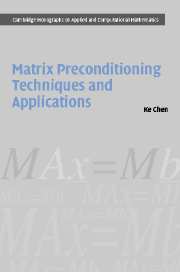Book contents
- Frontmatter
- Contents
- Preface
- Nomenclature
- 1 Introduction
- 2 Direct methods
- 3 Iterative methods
- 4 Matrix splitting preconditioners [T1]: direct approximation of An×n
- 5 Approximate inverse preconditioners [T2]: direct approximation of An×n−1
- 6 Multilevel methods and preconditioners [T3]: coarse grid approximation
- 7 Multilevel recursive Schur complements preconditioners [T4]
- 8 Sparse wavelet preconditioners [T5]: approximation of Ãn×n and Ãn×n−1
- 9 Wavelet Schur preconditioners [T6]
- 10 Implicit wavelet preconditioners [T7]
- 11 Application I: acoustic scattering modelling
- 12 Application II: coupled matrix problems
- 13 Application III: image restoration and inverse problems
- 14 Application IV: voltage stability in electrical power systems
- 15 Parallel computing by examples
- Appendix A a brief guide to linear algebra
- Appendix B the Harwell–Boeing (HB) data format
- Appendix C a brief guide to MATLAB®
- Appendix D list of supplied M-files and programs
- Appendix E list of selected scientific resources on Internet
- References
- Author Index
- Subject Index
- Plate section
12 - Application II: coupled matrix problems
Published online by Cambridge University Press: 06 January 2010
- Frontmatter
- Contents
- Preface
- Nomenclature
- 1 Introduction
- 2 Direct methods
- 3 Iterative methods
- 4 Matrix splitting preconditioners [T1]: direct approximation of An×n
- 5 Approximate inverse preconditioners [T2]: direct approximation of An×n−1
- 6 Multilevel methods and preconditioners [T3]: coarse grid approximation
- 7 Multilevel recursive Schur complements preconditioners [T4]
- 8 Sparse wavelet preconditioners [T5]: approximation of Ãn×n and Ãn×n−1
- 9 Wavelet Schur preconditioners [T6]
- 10 Implicit wavelet preconditioners [T7]
- 11 Application I: acoustic scattering modelling
- 12 Application II: coupled matrix problems
- 13 Application III: image restoration and inverse problems
- 14 Application IV: voltage stability in electrical power systems
- 15 Parallel computing by examples
- Appendix A a brief guide to linear algebra
- Appendix B the Harwell–Boeing (HB) data format
- Appendix C a brief guide to MATLAB®
- Appendix D list of supplied M-files and programs
- Appendix E list of selected scientific resources on Internet
- References
- Author Index
- Subject Index
- Plate section
Summary
A clustered [eigenvalue] spectrum often translates in rapid convergence of GMRES.
Michele Benzi and Gene H. Golub. SIAM Journal on Matrix Analysis and Applications, Vol. 24 (2003)The coupled matrix problems represent a vast class of scientific problems arising from discretization of either systems of PDE's or coupled PDE's and integral equations, among other applications such as the Karush–Kuhn–Tucker (KKT) matrices from nonlinear programming [273, 43]. The reader may be aware of the fact that many coupled (nonlinear) systems may be solved by Uzawa type algorithms [92, 153, 144, 115], i.e. all equations are ‘artificially’ decoupled and solved in turns. A famous example of this strategy is the SIMPLE algorithm widely used in computational fluid dynamics along with finite volume discretization [473, 334]. While there is much to do in designing better and more robust preconditioners for a single system such as (1.1), one major challenge in future research will be to solve the coupled problems many of which have only been tackled recently.
This chapter will first review the recent development on a general coupled system and then discuss some specific coupled problems. The latter samples come from a large range of challenging problems including elasticity, particle physics and electromagnetism. We shall discuss the following.
- Type
- Chapter
- Information
- Matrix Preconditioning Techniques and Applications , pp. 400 - 414Publisher: Cambridge University PressPrint publication year: 2005



